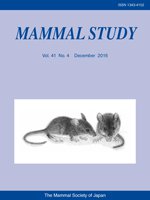We morphologically examined the functions of mastication muscles in Carnivora to clarify their evolutionary diversification. We measured the physiological cross-sectional area (PCSA) of the mastication muscles in 18 species of Carnivora belonging to six families and 17 genera. PCSA of all mastication muscles correlated to the body size of species. In addition, PCSA of the mastication muscles was also determined by the phylogenetic factor in Carnivora. Felidae showed significantly the higher ratio of PCSA of the whole masseter and PCSA of the superficial masseter muscles against PCSA of total muscles and the residuals of PCSA of medial pterygoid, whole masseter and superficial masseter muscles of Felidae were well larger compared with those of the other families. We suggest that the tendency of PCSA is toward functional adaptation for facilitating contact of the upper blade of the carnassial against the lower blade. Mustelidae possessed the highest ratio of PCSA of the temporalis muscles per PCSA of total muscles. Since the mandibular condyle of Mustelidae deeply fits into the glenoid fossa, temporomandibular dislocation does not usually occur, and thus members of Mustelidae can recruit their large temporalis for biting without the danger of temporomandibular dislocation.
How to translate text using browser tools
1 December 2016
Compartive Study of Physiological Cross-Sectional Area of Masticatory Muscles among Species of Carnivora
Kai Ito,
Hideki Endo
ACCESS THE FULL ARTICLE

Mammal Study
Vol. 41 • No. 4
December 2016
Vol. 41 • No. 4
December 2016
Carnivora
masseter muscle
mastication muscle
physiological cross sectional area
temporalis muscle




